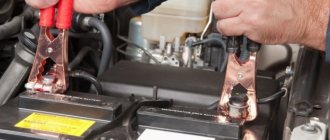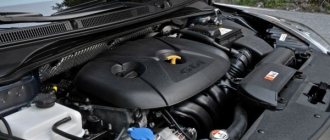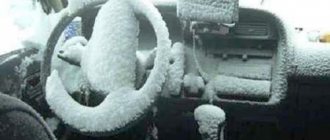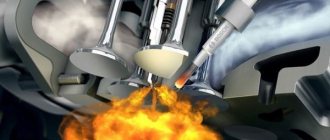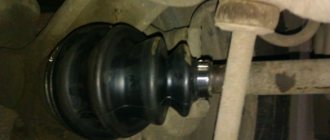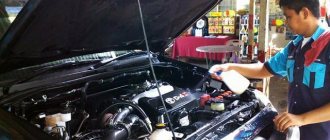The anti-lock braking system (abbreviated as ABS), which prevents the car from skidding during sudden braking, is installed on most passenger cars, including domestic ones. Since a considerable part of car enthusiasts are engaged in independent maintenance and repair of their “iron horses,” a logical question arises about how to properly bleed ABS brakes in a garage. To get a comprehensive answer, you need to find out how the new system differs from the old one and consider air removal technology.
Additional elements of brake circuits
The disadvantage of old brakes was that one or more wheels would lock when the pedal was pressed to the floor. As a result, the car lost control and skidded, especially on slippery roads. Later, the traditional system was modernized by adding the following elements:
- hydraulic valve block;
- electric pump;
- capacity - hydraulic accumulator;
- wheel rotation sensors;
- electronic control module (ECU).
The listed components and parts are components of the anti-lock braking system. Thanks to them, a car with ABS never skids, since the automatic system simulates repeated sharp presses on the brake pedal, although the driver presses it all the way.
There are 2 types of brake circuits on cars: three- and four-channel. In the first case, the front wheels are connected to the main brake cylinder by separate branches, and the two rear wheels are connected by a single circuit. In the second scheme, each wheel has its own liquid line.
To understand the difference between bleeding a brake system with ABS, it’s worth understanding its operation:
- When the driver brakes under normal road conditions, the sensors on the wheels record approximately the same deceleration (taking into account turning) and the ABS does not manifest itself at all.
- When you press the pedal sharply, one or more wheels lock and rotate slower than the others, which the sensor reports to the ECU.
- At the command of the controller, the hydraulic unit opens the corresponding valve and the pressure in the circuit of the stopped wheel drops. Excess brake fluid flows into a storage tank.
- The pads release the disc (or drum) and the wheel spins along with the rest. But since the goal is to brake quickly, the ECU switches the valves again, the pads “grab” and hold the disc until the sensor detects the lock again. The cycle repeats until it stops completely.
- To prevent pressure in the master cylinder from dropping during valve actuation, an electric pump replenishes the brake fluid by pumping it from the hydraulic accumulator.
One described cycle takes a fraction of a second. The interaction of the fluid circuits with ABS is felt when the pedal is fully depressed. Due to the rapid operation of the valves and the pumping of fluid, the driver feels a series of shocks.
Checking the system for leaks: process features
The first thing to remember when working with the brake system is the fact that the fluid is toxic. From a technogenic point of view, it is harmful and dangerous to human health. In case of contact with skin, open areas of the body or mucous membrane, of course, rinse the affected area, and then be sure to contact a medical facility.
Some brands of brake fluid are flammable, so you should avoid direct contact with hot parts of the car, for example, the exhaust manifold. It is important to always adhere to the basics of fire safety.
Preparing for pumping
As a rule, air entering lines and units is associated with a malfunction or its elimination. It is necessary to remove air bubbles that interfere with effective braking after disassembling the calipers, disconnecting the pipes or repairing the master cylinder.
The operating algorithm of the automation and hydraulic unit present in the vehicle’s braking system provides for maintaining high pressure in the main fluid circuit. If the air removal procedure is started without proper preparation, liquid may be released. Therefore, before bleeding ABS brakes, the pressure must be reduced. This is achieved by pressing the pedal 20 times with the ignition off.
What you will need for work:
- WD-40 aerosol lubricant;
- a spanner for unscrewing the fittings on the working cylinders of the wheels;
- a plastic bottle and a tube that matches the diameter of the fitting;
- a supply of fresh brake fluid.
Important! If in your car the hydraulic accumulator, valve and pump units are installed in different places or combined with elements of another automatic system - ESP, then you should not attempt to pump them yourself. You will need a special scanner that interacts with the electronic valve control unit.
The last step before bleeding is to turn off the ABS. To do this, take the operating instructions, open the fuse diagram and find the one that is responsible for the operation of this system. Then remove it from the slot.
If the design of the front and rear suspension allows, then you don’t have to remove the wheels - unscrew the fittings from the inspection ditch.
Bleeding brakes via VAG-COM (Vasya the diagnostician)
The original is here https://www.drive2.ru/l/4651505/
When at the services I asked to bleed the brakes through a Vag-com, everyone looked at me like I was an idiot! And they said: “Now we’ll pump it up as usual and everything will be fine!” And what's the result? It is IMPOSSIBLE to expel air from the ABS unit either with your feet or with pressure! If your ABS unit is inflated, you have lost fluid in the compensation tank, even if you pump your feet with pressure, everything will be useless! 1.5 years after installing the Q5 calipers, I was convinced of this personally. Where and how they pumped my brakes, both at the dealer and in vag services, and I pumped them myself (my wife pumped up her legs quite well). I spent a lot of money, brake fluid and nerves on this! But the pedal remained the same wobbly! Of course, it began to catch earlier after installing the vacuum seal with the GTZ from the RS5. But I still felt a little fuzzy. Knowing that this can be done programmatically on a Skoda, I began searching for information on all forums in the world on how to do this on an Audi. And everywhere it’s the same thing... With kicks, under pressure... But still, I managed to find some information. Based on which I found the function I needed...
We hang up the car and remove all the wheels...
Next, prepare 4 bottles and 1 liter of VAG brake fluid
We had to dig in the brake block - 03, then go to the basic parameters - 04
But here we had to look for where the treasured group was. Everywhere I found information it was 001 or 002 group. On our cars there was simply an ERROR)))) I was upset at first, but decided to look further. Having reached group 010 I saw what I was looking for
Next there will be just photos, from which everything should be clear.
The only thing here is that there is no photo where he asks to press the brake 10 times! At this time, the pump turns on and you need to try to get into the rhythm of the work... That is, you should feel the vibration of the brake pedal while pressing!
Now the whole algorithm of actions is point by point: 1) Raise the car, remove the wheels 2) Connect a tube with a bottle to collect fluid to the fittings of each wheel 3) Open the compensation tank and add as much fluid as possible 4) Have one person add fluid while pumping 5) Next, go to the Brake System Unit - 03 6) Next, go to Basic Parameters - 04 7) Next, select group 010 Open the front wheel fittings (I opened the internal fittings) 9) Press “On/Off/Next” and the pump starts humming and a window appears asking you to press the pedal 10 times. We don’t press 10 times until it stops on its own! And an inscription about closing the fittings will appear. DO NOT PRESS “On/Off/Next” 10) Next, very quickly close the front fittings 11) And only THEN press “On/Off/Next”. 12) We also very quickly open the rear caliper fittings! 13) And press “On/Off/Next” and the pump begins to hum and a window appears asking you to press the pedal 10 times. We don’t press 10 times until it stops on its own! And an inscription about closing the fittings will appear. 14) Click “On/Off/Next” and see the treasured inscription - Partial pumping complete!
Why do I write to close the fittings very quickly? If you do it slowly, the computer will simply reset everything and you will have to start all over again!
I did this procedure for myself 2 times. The break between procedures is 20 minutes to allow the ABS pump to cool down.
After which I made a test drive, braked several times so that the ABS would work, and after making sure that everything was working, I did a test with the third block performers! It definitely won't be redundant.
We go to the brake block - 03, then performer test - 03... and according to the instructions, he will write everything. Don't be alarmed, it will buzz loudly. When it asks you to depress the brake pedal, press further, the pump starts humming - keep the pedal depressed for no more than 15 seconds...
That's all! This is where all my 1.5 year torments ended! The pedal grips just like on stock, at the very top and no longer presses)))
Features and design of the Renault Logan brake system
The design of the brake system, not counting emergency and emergency situations, provides for mandatory bleeding of the brakes in the following cases:
- When replacing brake fluid or if its level has dropped below the permissible level in the reservoir. Any visible and hidden depressurization is also a serious reason for performing the procedure.
- After replacing brake hoses, cylinders or pressure regulator. When replacing the VUT and GTZ, it is also worth carrying out a primitive bleeding to achieve normal and uninterrupted operation of the brake system.
Detailed instructions for bleeding the brake system
The first thing you must remember is that you must not use previously drained waste fluid. This is fraught with both the insides of the car and its owner in terms of safety. Read the manufacturer's recommendations. First of all, it is important to drain the existing liquid into a prepared container. To do this, use a rubber tube.
After the fluid has been drained from the reservoir, depress the brake several dozen times. Twenty will be enough. The system is sealed, and the liquid in it is under a pressure of 180 atmospheres, so to avoid dangerous situations during repairs, it is better to get rid of it in advance.
We have prepared a detailed description of the process for you:
- Remove the protective cap on the main tank.
- Drain all the liquid inside it and that which is in the pressure tubes.
- Fill with new fluid up to the mark at the top edge.
- Place the car on the handbrake, and install anti-roll blocks under the wheels on a slope.
- Remove the tubes from the exhaust valves. It is important to clean both elements of dirt, oil and other debris that accumulates there throughout the year.
- Place the rubber tube over the outlet valve. Place the other end of the tube into the prepared container.
- At intervals of several seconds, ask a friend to squeeze the brake all the way. This will get rid of the old fluid that is already inside.
- Lock the valve after all the waste has come out.

